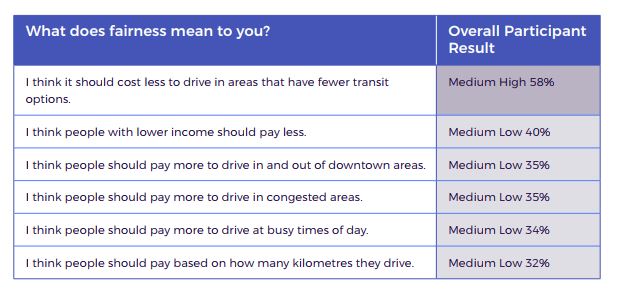We’re getting a better idea of how drivers in Metro Vancouver might be charged under the region’s proposed mobility pricing scheme.

Metro Vancouver’s mayors have argued the scheme is necessary in order to fund major transportation projects such as Surrey light rail transit (LRT) and the Pattullo Bridge replacement, along with cutting congestion in the region.
WATCH: Mobility pricing commission considers congestion, distance tolling
An independent commission was formed last fall to address the issue, and was charged with three main goals according to Mobility Pricing Commission executive director Daniel Firth.
“How you could introduce something that would address congestion, raise some revenues, and do that in a way that is fair,” he told CKNW’s The Simi Sara Show.
“I think we’ve all known from the beginning that the fairness piece of this is the most important, obviously.”
The commission has now released a preliminary report, narrowing its options for potential mobility pricing to two.
The first is “congestion point charges” — either a system of fixed tolling points at intersections, bridges or tunnels, or tolling zones where drivers pay for entry and exit to a defined area.
The second is distance-based charges that vary by time and location, with drivers in some areas paying more per kilometre during busy times of the day.
WATCH: Metro transit plan: What is mobility pricing?
The commission said it studied congestion charges in countries around the world, and selected the two approaches out of 10 possible options.
The commission will now begin an in-depth study of the two proposed models, and collect more public feedback in late January.
It says it will also take a second look at the fuel tax and the pricing of both public and private paid parking as complementary options.

Get breaking National news
Firth said the commission recognizes that no one is excited about spending more on transportation, but that public feedback suggested people also recognized the need to act.
“I think what we’re getting is a sense of people are very frustrated about the congestion in the region that’s growing and having an impact on people’s quality of life and the region’s economy.”
Other ideas that it said could form later stages of a long term decongestion plan include mandatory “corridor charges,” where all drivers on a specific route are charged, a flat-fee per-kilometre charge and an annual vehicle levy.

The report found the public was least interested in a system that charged drivers per kilometre driven, and was most supportive of a system that charged less in areas with poor transit service.
LISTEN: View from Victoria – Don’t call it a toll
It also found the public was concerned about fairness and affordability. However, it found people were interested in more predictable travel times and expanded public transit.
A question of fairness
Premier John Horgan says the province is eager to have to look at whatever model the Mayors’ Council comes up, but says he’s focused on whether it squares with his government’s focus on affordability.
“I don’t want to see inconsistent policies come forward from other jurisdictions. We’ll have to work, of course, with the Mayor’s Council,” he said.
WATCH: Mobility Pricing Commission begins public hearings

Speaking for the opposition BC Liberals, West Vancouver MLA Jordan Sturdy said he’s also open to the concept, so long as no regions are unfairly penalized.
“I think that there’s opportunity here, in the long run, to develop some options that are fair and equitable and reflect the geography that we live in,” he said.
New Westminster mayor Jonathan Cote said he felt the two options put forward by the commission were the best on the table, but that leaders now need to convince the public the changes will be fair and genuinely improve commuters’ lives.
- One of Kimberly Proctor’s killers denied parole again, board believes he is still a risk
- Atmospheric river forces closure of all major highways between Lower Mainland, Interior
- Egypt and Iran protest Seattle FIFA match over Pride celebrations
- Highway 1 east of Golden, B.C. closed due to crash, snowy weather
“For any recommendation to be successful and get buy-in from the public there’s going to have to be regional fairness and a general feeling that if certain areas are being charged, that those areas are also seeing other improvements, whether that be improvements in road infrastructure or new public transit access,” he said.
“Those two things have to be combined together.”
South of the Fraser, Langley City Councillor Nathan Pachal said he believes the options on the table will actually increase fairness for drivers.
“When you add a comprehensive system of point charges that are smaller and reasonable you’ll be able to reduce congestion, it’ll be more equal and it will probably be a lower cost than it was in the past.”
Newly appointed head of the BC Trucking Association Dave Earle said his group needs to know more about each option on the table — but that the association is focused on a few specific points.
“The quality of costs towards different road user groups, addressing the infrastructure challenges inside the Lower Mainland, and really making sure that we’re using what we have as efficiently as possible.”
The commission said dates for the next phase of its mobility pricing study will be published here in the coming weeks.
-With files from Liza Yuzda and Janet Brown








Comments